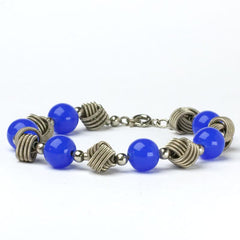
I cannot let this year end without telling you about the centenary of an important influence on one style of 1930s jewelry – the Bauhaus, a school of design founded in 1919 in Germany. You may be familiar with the modernist buildings and decorative arts that flowed from its philosophy – for example, the Seagram Building in New York City and the Barcelona chair. Both were designed by German-born architect Ludwig Mies van der Rohe. He also designed the first tower of the Toronto-Dominion Centre, a complex of office buildings shown above.
1930s Jewelry
What does the Bauhaus have to do with 1930s jewelry? The style that emerged from the school’s teachings inspired jewelry designers to use stainless steel, chrome, and nickel, either alone or with embellishments in glass, plastic, and/or enamel. Designs were austere and geometric in form. Pieces reflected the new emphasis on mass production with symbols of the machine and its movement. Here are some of my favorite pieces in this style.
Jakob Bengel
One of the most significant costume jewelry makers in this era was Jakob Bengel. Established in 1873, this German firm changed its focus from watch chains and metal wares to costume jewelry in the 1920s. Greatly influenced by the Bauhaus metal shop and French avant-garde jewelry designers, Bengel’s pieces are highly-coveted today.

A popular motif – known as Mauerwerk – can be seen in this Chrome Brickwork Collar. This pattern was fashioned from flat metal links held together with invisible rods that make the rigid-looking piece extremely flexible. The necklace feels very slinky when worn. Bengel made many variations on this pattern in necklaces and bracelets.

This Chrome & Glass Link Necklace & Bracelet (now sold) was initially attributed to a Belgian maker but has since been thought to be a Bengel creation. The mystery persists because that firm and most of their contemporaries never signed their jewelry. Nonetheless, this set is a knockout! The necklace has inter-locking chrome links with accents of molded-glass; the bracelet is formed from glass links joined with chrome.
Other Makers
Here are three Bauhaus-inspired bracelets.
 |
 |
 |
On the left, the Blue Bead & Chrome Knot Bracelet illustrates another popular motif – spiral knots formed from wire – used by Bengel and others. In this piece, most likely made by another firm, the knots alternate with blue-glass beads and tiny chrome balls.
The Black & White Bakelite Vintage Charm Bracelet in the center may have been made in France. Its silver-tone links in a tank-track pattern are another popular Machine Age motif. The dangling black-and-white plastic cubes that look like licorice Allsorts candy add physical movement to the theme. A truly fun piece!
I like the Chrome Link Machine Age Bracelet on the right because it has a combination of smooth and textured links. The trios of curved, polished-chrome were inspired by a machine symbol: car or radio grills. Because the piece is metal only, you can wear it with virtually anything! Although the bracelet is unsigned, I am certain it was made in Europe.
 |
 |
For More 1930s Jewelry
The characteristics of the Machine Age style of the 1930s were not limited to the Bauhaus influence. Many pieces with this motif were made without metal (e.g., only plastic), and many were embellished with diamanté and/or colored stones. You can see a fine selection of this jewelry in the boutique’s Machine Age collection.
More About the School
From 1919 – 1933, the school focused on the designer’s relationship with industry, by emphasizing the unity of the fine arts and applied arts. Its aim was to design functional and aesthetically-pleasing items for everyday use through mass production, so they were affordable to all.

The one-year foundation course immersed students in color theory, material studies and basic principles of design. For the next two years, students entered specialized workshops, each led by both an artist and master craftsman. Courses included metal-working, cabinet-making, weaving, pottery, photography, typography and painting. The school's signet, shown here, was designed by Oskar Schlemmer, one of the instructors.
To celebrate the centenary of the school’s founding, festivals, exhibitions, and other special events have been held around the world throughout this year. On April 12, even Google issued a commemorative Doodle.
Dezeen, the online architecture and design magazine, calls the Bauhaus “the most influential art and design school in history … a place that despite the economic turmoil and cultural conservatism of the world around it, offered a truly radical, international and optimistic vision of the future”. Although the school lasted little more than a decade, its teachers and graduates applied its modern design ideals worldwide. Fortunately, we are left with a wonderful legacy in all fields of the arts.

Leave a comment